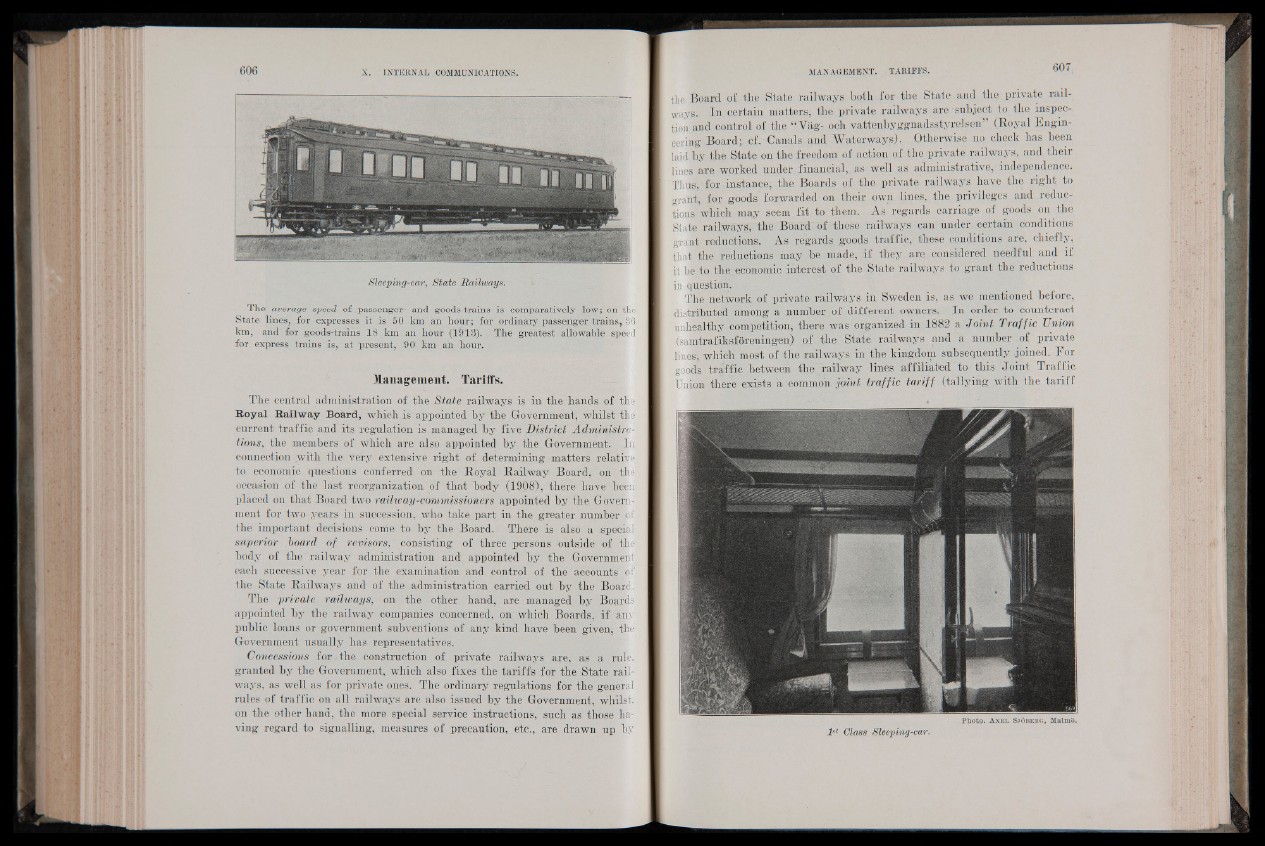
Sleeping-car, State Railways.
The average speed of passenger- and goods-trains is comparatively low; on the
State lines, .for expresses it is 50 km an hour; for ordinary passenger trains, 36
km, and for goods-trains 18 km an hour (1913). The greatest allowable speed
for express trains is, at present, 90 km an hour.
Management. Tariffs.
The central administration of the State railways is in the hands of the
Royal Railway Board, which is appointed by the Government, whilst the
current traffic and its regulation is managed by five District Administrations,
the members of which are also appointed by the Government: In
connection .with the very extensive right of determining matters relative
to economic questions conferred on the Royal Railway Board, on the
occasion of the last reorganization of that body (1908), there have been
placed on that Board two railway-commissioners appointed by the Government
for two years in succession, who take part in the greater number of
the important decisions come to by the Board. There is also a special
superior board of revisors, consisting of three persons outside of the
body of the railway administration and appointed by the Government
each successive year for the examination and control of the accounts of
the State Railways and of the administration carried out by the Board.
The private railways, on the other hand, are managed by Boards
appointed by the railway companies concerned, on which Boards, if any
public loans or government subventions of any kind have been given, the
Government usually has representatives.
Concessions for the construction of private railways are, as a rule,
granted by the Government, which also fixes the tariffs for the State railways,
as well as for private ones. The ordinary regulations for the general
rules of traffic on all railways are also issued by the Government, whilst,
on the other hand, the more special service instructions, such as those having
regard to signalling, measures of precaution, etc., are drawn up by
theiBoard of the State railways both for the State and the private railways.
In certain matters, the private railways are subject to the inspec-.
tion and control of the “Vag- och vattenbyggnadsstyrelsen” (Royal Engineering
Board; cf. Canals and Waterways). Otherwise no check has been
laid by the State on the freedom of action of the private railways, and their
lines are worked under financial,_as well as administrative, independence.
Thus, for instance, the Boards of the private railways have the right to
grait, for goods forwarded on their own lines, the privileges and reductions
.which may seem, fit to them. As regards carriage of goods on the
State railways, the. Board of these railways can under certain conditions
grant reductions. As regards goods traffic, these conditions are, chiefly,
that the reductions may be made, if they are considered needful and if
it be to the economic interest of the State railways to grant the reductions
in question.
The network of private railways in Sweden is, as we mentioned before,
distributed among a number of different owners. In order, to counteract
unhealthy competition, there was organized in 1882 a Joint Traffic Union
(samtrafiksforeningen) of the State railways 'and a number of private
lines, which most of the railways in the kingdom subsequently joined. Eor
goods traffic between the railway lines affiliated to this Joint Traffic
Union there exists 'a common joint traffic tariff (tallying with the tariff
1st Class Sleeping-car.
Photo. A x e l S j ö b e r g , M a lm ö ;